New SLoCaT report shows the critical role of sustainable transport in achieving the SDGs
The SLoCaT Partnership has released a new report, ‘Sustainable Transport: A Critical Driver to Achieve the Sustainable Development Goals,‘ to summarise how transport has been reflected in the first quadrennial VNR reporting cycle from 2016 – 2019.
Safe, efficient, low carbon, and affordable mobility for all is essential to sustainable human development and must be enabled in all sustainable development policies. Transport is central to powering lives and livelihoods. It is the engine of the global economy and helps spur human development. Every day, people all over the world depend on a variety of transport modes to make a living, go to school, access essential goods and services, and ultimately, enhance equal opportunities for participation in society. With growing transport demand and impacts, the sustainability of the transport sector must improve to meet sustainable development and climate action targets.
Sustainable transport is a cross-cutting theme in the 2030 Agenda for Sustainable Development. It supports the achievement of at least 8 of the 17 Sustainable Development Goals (SDGs) and makes direct and indirect contributions to at least 13 SDG targets. In addition, transport is directly related to five SDG indicators:
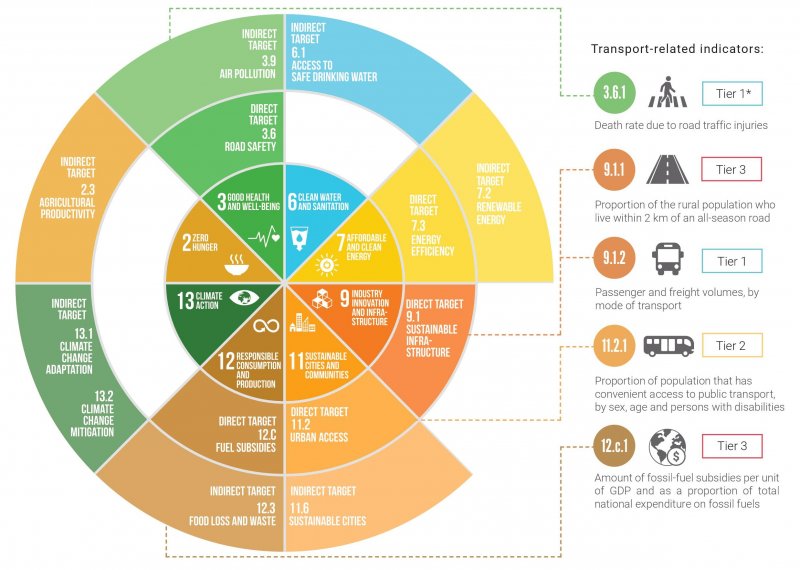
The 2030 Agenda encourages member states to submit Voluntary National Reviews (VNRs) to the United Nations High-Level Political Forum on Sustainable Development (HLPF), which has been convening annually since 2016 under the auspices of the United Nations Economic and Social Council (ECOSOC). The VNR process aims to facilitate the sharing of experiences among countries, including successes, challenges and lessons learned, with a view to accelerating the implementation of the 2030 Agenda.
Since the first HLPF in 2016, the SLoCaT Partnership has been assessing transport references in the VNRs submitted each year. The assessment aims to:
- Provide a useful resource for policy-makers to better understand the role of transport in achieving the SDGs;
- Outline recommendations to policy-makers on goal-setting, implementing and reporting on sustainable transport progress;
- Help the transport community (and other relevant sectors e.g. energy, health) better understand the pattern, gaps and opportunities in reporting sustainable transport in the VNR process.
Throughout the lifespan of the HLPF, countries have been reporting on transport as a vital sector to implement SDGs, showcasing on-the-ground implementation and best practices. Through the VNRs, countries contribute to offer leverage and momentum for the transport sector to move along a more sustainable path.
During the first quadrennial reporting cycle from 2016 to 2019, 92% of the submitted VNRs have highlighted progress made in the transport sector.
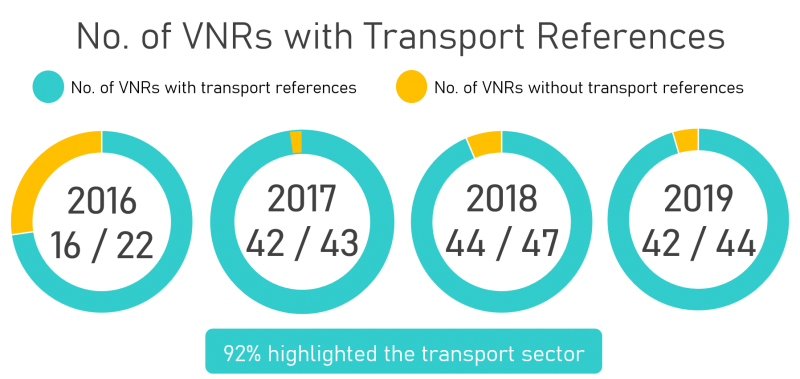
Only 30% of VNRs have included explicit references to transport sustainability impacts. The linkages between transport and infrastructure- and energy-oriented SDGs are clear, but further attention must be paid to the social dimension of sustainable development, thus establishing a stronger case as to how transport contributes to the overarching goals of the 2030 Agenda on poverty alleviation, food security, social equity and ‘Leaving No One Behind’.
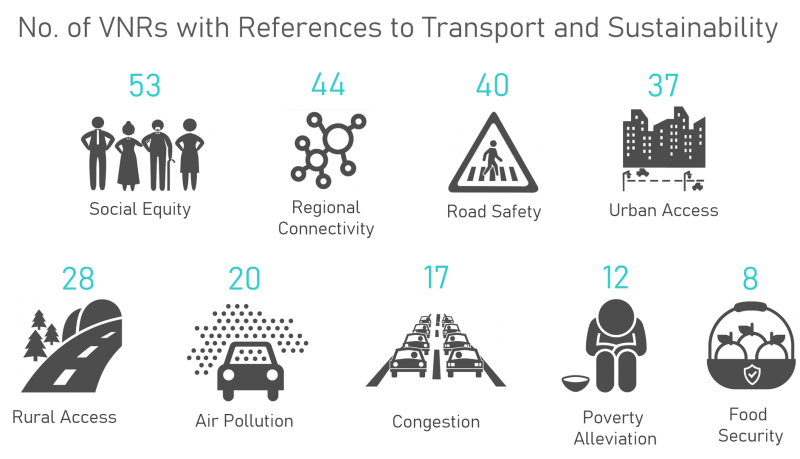
A more balanced, long-term vision for sustainable transport planning is needed. Countries should better demonstrate tangible progress on sustainable transport in their VNRs by:
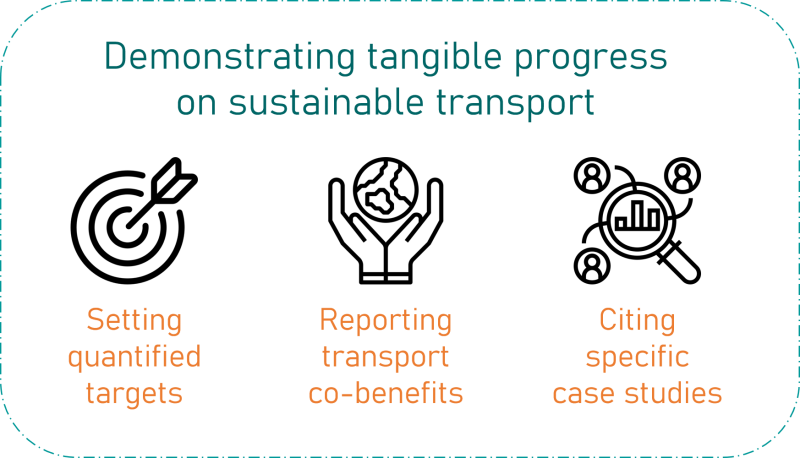
18% of the submitted VNRs reported specific targets covering 12 areas in sustainable transport. The majority of targets are short-to-medium term targets (2020 and 2030), with five countries setting long-term targets for 2050.
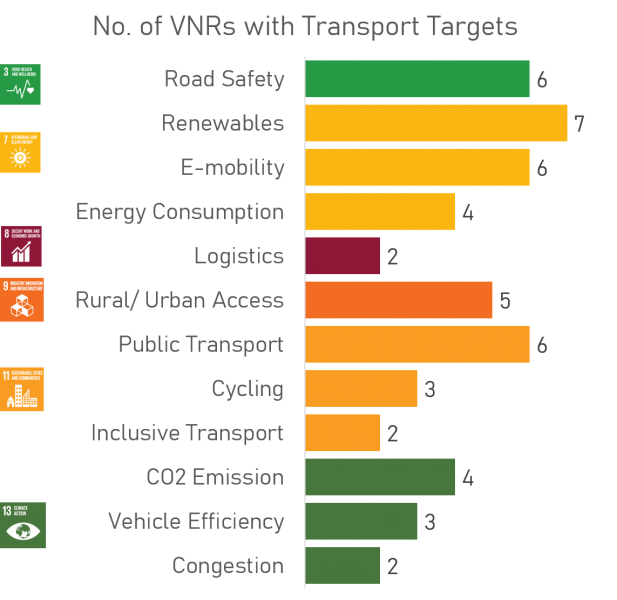
Robust coordination and support from SDG-lead agencies are required to maximise the contribution of the transport sector within the national development framework for short-/ medium- and long-term planning. Establishing such a harmonised long-term strategy with ambitious vision and specific targets could enable the implementation of transport measures to maximise wide sustainability impacts.
The full potential of the transport and wider mobility sector to contribute to a balanced achievement of the SDGs remains untapped. VNRs can unleash a more comprehensive vision and assessment of sustainable, low carbon transport development. This would require countries to further understand and enable this cross-cutting sector, as well as its capacity to foster interlinkages across the SDGs and hence integrated and systemic policy approaches. HLPF formats can further facilitate thematic discussions and learning about interconnecting topics and measures.
The SLoCaT Partnership has developed a framework with a step-by-step methodological approach to assist transport sector policy-makers in translating SDGs in national sector plans, strategies and budgets; designing policy interventions to target resources at root bottlenecks; and providing coordinated and pooled policy support for sustainable transport development.

The framework helps transport sector decision makers take long-term policy and investment decisions to make transport sector infrastructure and operations more sustainable and low-carbon. Taken together, these elements can contribute to a comprehensive transformation of the transport sector and accelerate the implementation of all SDGs.
The report is available here: www.slocat.net/vnr